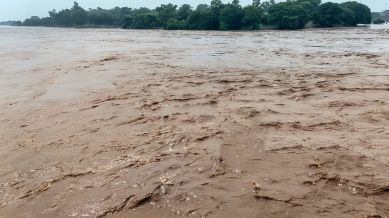Stay updated with the latest - Click here to follow us on Instagram
42 breaches & counting but Punjab govt report listed 8 points on Ravi for flood readiness
We had cleared silt, raised embankments, but nobody could have predicted this much rain: Minister.

The Punjab government had prepared a study with 133 vulnerable points on major rivers and tributaries after the 2023 floods, which saw 241 breaches at 134 locations in the state.
The report prepared by Punjab Water Resources department in 2023 had identified eight vulnerable points on Ravi river for flood preparedness. However, so far this monsoon, the Ravi river breached at 42 locations inundating scores of villages.
monthly limit of free stories.
with an Express account.
“The 2023 report had highlighted 133 vulnerable points in Sutlej, Beas and Ghaggar rivers and we had also prepared for it. But for the first time in the river’s recorded history, Ravi turned out to be the worst. We could not have anticipated it. This year, there was so much rainfall in the catchment area of Ravi that at one point of time, the river carried 14.5 lakh cusecs of water. By no means anybody could have controlled this much amount of water,” said a government functionary, adding that they are in the process of preparing a fresh report on breaches.
He added that the department also fixed a lot of locations and so breaches were way lesser on Sutlej, Ghaggar and Beas river embankments. “In Gidderpindi village near Lohian in Jalandhar, we desilted the Sutlej river and raised the bund by five feet. This vulnerable point had flooded at least 50 villages in 2019. We removed 1 crore cubic foot silt from the area and supplied it to National Highways Authority of India (NHAI) for road projects,” he added.
As per the government’s report, the maximum vulnerable points were 16 each in Ropar on the Sutlej river and in Amritsar on Beas river. This was followed by 14 in Jalandhar, 12 in Hoshiarpur, nine in Ludhiana, eight in Kapurthala, seven each in Nawanshahr and Muktsar, six each in Ferozepur, Tarn Taran and Patiala, five in Fazilka, four in Moga, three each in Pathankot, Gurdaspur and Mohali, two each in Sangrur, Malerkotla, Mansa and one each in Barnala and Bathinda.
Defending the report, an official said that hydraulics is a study of probability as one cannot predict the exact rain. “Many a times studies have failed to predict the exact damage. This year, we plan to raise the embankment of Ravi by three feet, but the people don’t want to give us the land,” he said.
“Although there was overflow at 42 points in Ravi, some bundhs were not pucca. The Sutlej witnessed two embankment damages at Sasrali in Ludhiana and Burj Tehal Singh Wala in Nawanshahr. But since flooding didn’t take place, it’s not technically a breach. This year, Ghaggar had 15 times more water than 2023 but there was no risk as we had raised the embankment by 2.5 feet,” an official said, adding that the Ghaggar overflowed in border villages of Patiala due to siphons on Hansi-Butana canal. “This is a construction defect and we have taken it up with Haryana.”
Water Resources Minister Barinder Goyal said that such floods take place in 100 years. “There was so much water that the system was overwhelmed. We were prepared. We had worked so hard that there was no breach in Ghaggar even when it was flowing above the danger mark. What can one do if it rains heavily and the rivers are forced to carry water way above its capacity,” he said.
What the study mentioned
The study also elaborated on why Punjab gets flooded almost every year. In Punjab, the most common cause of floods is heavy rainfall. The monsoon season, which lasts from June to September, gives Punjab 75 per cent of its rainfall. Sometimes, the rainfall exceeds the capacity of the soil to absorb or the drainage system to carry excess water, resulting in floods. Inadequate reservoir management also causes flooding downstream.
Citing an example from 2023, the report states that a railway bridge in a village along the Sutlej had become a bottleneck. Despite being designed for high discharge, the bridge’s waterway was disproportionately large, causing sediment accumulation during the lean period. Consequently, the reduced flow velocity led to silting, narrowing the current creek flow. When it rained, the accumulated sediment obstructed water flow, exacerbating flooding in the area.
The report also accepted that encroachments obstructed the flow of water. In the time of heavy rainfall there is not proper way out for the flowing water due to obstruction created by unregulated development on the river banks of the river system.
Plantation of Poplar and Eucalyptus trees on river bed also hindered the flow of the drain.